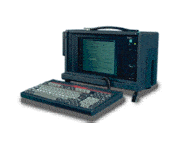by Tim Gorter, Teletechnics Afield
Sunday, August 08, 1999
In today’s fast moving newsgathering market, the wish for a lightweight portable SNG facility is becoming increasingly requested. Both Toko and Livewire have responded to this, with a unit enabling video transmission over portable satellite terminals. Using their encoding terminal and an Inmarsat HSD (High Speed Data) capable satellite telephone, material can
 Livewire’s “Voyager” |
be sent to the broadcasters home studio. Livewire’s product “Voyager” is PC based, thus being capable of all the standard Microsoft Windows programs as well as the video encoding and sending function, whereas the Toko “VAST-P” is a completely integrated system with top panel button operation only.
Although both systems differ slightly in operation and functionality, the principal of the two remain the same. Video material is played onto and recorded in a digital format on the encoder. The quality of the material is decided by the encoding speed selected during the digitising process.
The encoding is MPEG-1 based, which allows for the smaller file sizes that then can easily be sent over Inmarsat. Most DSNG transportable Flyaway systems used by media in major news and sport operations use MPEG-2 based systems.
 Toko’s “VAST-P” |
The Toko VAST-P encodes at 1Mbps, 1.5Mbps or at 2Mbps (labeled as LO, MID, and HI picture quality respectively), whereas the Livewire Voyager in MPEG-1 settings is freely adjustable from about 0.5Mbps to 2.5Mbps. Of course the higher the encoding rate is set, the larger the file that is recorded will be and the longer it will take to transmit over an Inmarsat 64kbps (HSD) circuit.
MPEG-1 picture quality is somewhat lower than the standard expected for Broadcast television. In simple terms, it can be compared to HI-8 video material. A lot of camera movement causing constant picture change is not always handled very well, causing digital blocking as well as there being no definition in motions like the movement of hair in wind or alike.
Once the material has been recorded and encoded, it is ready for transmitting. Using an Inmarsat-A, B or the immanently to be launched M4 a connection is made with a receiving base terminal via the HSD circuit of Inmarsat and the terrestrial ISDN network.
Inmarsat has four geo-stationary satellites with which all of the earth is covered, with the exception of the poles. The Inmarsat-A & B are suitcase-sized terminals weighing approximately 30kg a piece. The cost of satellite time at HSD is between US$7 and US$15, dependant on the earth station used and the time of day. Inmarsat-M4 not having been released on to the market yet is pronounced to be a similar size to your average laptop computer and would be slightly cheaper to use.
Transmitting over a 64kbps HSD (single ISDN) circuit is the slowing factor in this system. A one-minute item encoded at 1.5Mbps can take as long as 20 minutes to transmit. Therefore, a lengthy story can often take more than an hour to reach the studio. Although once it has been transmitted completely, playback is immediately possible. The usual procedure would then be to re-record the item back on to tape for its further use. But the fact that Inmarsat and ISDN is a dial-up system, where no pre-booking of space segment is necessary, and it being a highly portable system makes this type of equipment very attractive for the rapid response news gathering business.
For further information and technical specifications, you should check the following websites:


